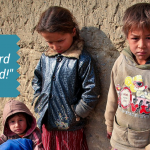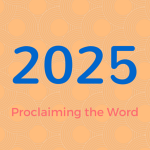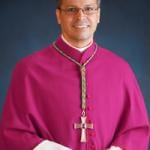Out today from the Vatican is news of a seminar being held November 2nd and 3rd, jointly organized by the Pontifical Academies of Sciences and of the Social Sciences and the World Federation of Catholic Medical Associations (F.I.A.M.C.). Titled “Trafficking in human beings: modern slavery. Destitute peoples and the message of Jesus Christ” will take on a the shocking and unthinkable crime of modern day slavery. According to the figures released by the organizers, the plague of this sin against humanity victimizes over 20 million people worldwide, with over 2 million victims of sexual trafficking.
We may think of human trafficking as a third world problem, but in reality we sometimes turn a blind eye to modern day slavery in our own communities. The State Department offers suggestions for helping to fight human trafficking, including being a conscientious consumer. One interesting thing you might do to better inform yourself is to measure your Slavery Footprint. By taking a simple survey, I discovered that my large home and severe addiction to electronic gadgetry left me with a whopping footprint:

A look at the US Labor Department’s list of Goods Produced by Child Labor or Forced Labor informed me of the likelihood that I’ve even recently (albeit unknowingly) perhaps supported slavery in the last week by purchasing tea in Rwanda. Can more mindful purchasing make a dent in this crime against humanity? I believe the answer is yes if we begin to work together to educate ourselves, to CARE.
To this end, a Tweet this week from Pope Francis (@Pontifex) gave me pause:
If money and material things become the center of our lives, they seize us and make us slaves
— Pope Francis (@Pontifex) October 29, 2013
I’ll be watching this seminar over the weekend and will report back here with any information that might be of help to you and your family.
A statement released today profiles the agenda for the meeting:
Following a wish expressed by Pope Francis, the Pontifical Academies of Sciences and of the Social Sciences, together with FIAMC (World Federation of the Catholic Medical Associations) are organizing a preparatory workshop on 2-3 November 2013 in the Casina Pio IV to examine human trafficking and modern slavery, in order to establish the real status quo and an agenda to combat this heinous crime. For example, natural sciences today can provide new tools that can be used against this new form of slavery, such as a digital registry to compare the DNA of unidentified missing children (including cases of illegal adoption) with that of their family members who have reported their disappearance.
No one can deny that “the trade in human persons constitutes a shocking offense against human dignity and a grave violation of fundamental human rights” and is an accelerator of criminal wealth creation in this new century. The Second Vatican Council already stated that “slavery, prostitution, the selling of women and children, and disgraceful working conditions where people are treated as instruments of gain rather than free and responsible persons” are “infamies” which “poison human society, debase their perpetrators” and constitute “a supreme dishonour to the Creator”. In one of the few documents of the Magisterium of the Popes on this issue, quoted at the beginning of these lines, the Blessed John Paul II added that “such situations are an affront to fundamental values which are shared by all cultures and peoples, values rooted in the very nature of the human person”. Moreover, he affirmed that the topic is a central one for the social sciences and natural sciences, in the context of globalization. “The alarming increase in the trade in human beings is one of the pressing political, social and economic problems associated with the process of globalization; it presents a serious threat to the security of individual nations and a question of international justice which cannot be deferred”.
According to the recent UNODC 2012 Report on Trafficking, the UN started being aware of this increasing crime only in the year 2000, together with the emerging effects of globalization and subsequently drafted a Protocol to Prevent, Suppress and Punish Trafficking in Persons, Especially Women and Children, supplementing the United Nations Convention against Transnational Organized Crime, which has been signed by 117 parties. According to the 2012Report, between 2002 and 2010 the International Labour Organization estimated “that 20.9 million people were victims of forced labour globally. This estimate also includes victims of human trafficking for labour and sexual exploitation” (p. 1). Each year, it is estimated that about 2 million people are victims of sexual trafficking, 60% of which are girls. Human organ trafficking reaches almost 1% of that figure, thus affecting around 20,000 people who are forced or deceived into giving up an organ (liver, kidney, pancreas, cornea, lung, even the heart), not without the complicity of doctors, nurses and other medical staff, who have pledged to follow Hippocrates’ oath Primum non nocere instead. But these chilling figures “represent only the tip of the iceberg, as criminals generally go to great lengths to prevent the detection of their activities” (p. 16). Some observers speculate that, within ten years, human trafficking will surpass drugs and weapons trafficking to become the most profitable criminal activity in the world. Recent trends, however, indicate that human trafficking is already in the first place, so that far from being a declining social crime, it is becoming ever more threatening. International sex trafficking is not limited to poor and undeveloped areas of the world – it is a problem in virtually every region of the globe. Countries with large (often legal) sex industries create the demand for trafficked women and girls, while countries where traffickers can easily recruit provide the supply. Generally, economically depressed countries provide the easiest recruitment for traffickers. The regions that produce the most sex trafficking victims are the former Soviet republics, Asia, and Latin America.
Because of the human and moral scandal they mean and interests involved, which lead to pessimism and resignation, many international institutions have turned their backs. This is why it is so important for the Pontifical Academies of Science and of the Social Sciences, together with the Federation of Catholic Medical Associations, to follow the Pope’s wish directly, sine glossa. Today, against these new forms of slavery, we need to readopt the same attitude as the Catalan Jesuit St Peter Claver, who saw African slaves in Latin America as fellow Christians and, when he was solemnly professed in 1622, signed his final profession document in Latin as: Petrus Claver, aethiopum semper servus (Peter Claver, servant of the Africans forever). In short, this great Saint embodies the great Christian revolution, unknown to the Greeks and the Romans and to all of the previous civilizations, which began explicitly with the famous letter of St Paul to Philemon. Indeed, St Paul urges Philemon to consider Onesimus “no longer as a slave, but something much better than a slave, a dear brother”. In other words, as stated in the Second Vatican Council, in our times “everyone must consider his every neighbour without exception as another self, taking into account first of all His life and the means necessary to living it with dignity, so as not to imitate the rich man who had no concern for the poor man Lazarus”, by recalling the voice of the Lord, “As long as you did it for one of these the least of my brethren, you did it for me” (Mt. 25:40).
We must thus be grateful to Pope Francis for identifying one of the most important social tragedies of our times and having enough confidence in our Catholic institutions to instruct us to organize this workshop. As He said during the canonization of the Mexican St Guadalupe García Zavala, “this is called ‘touching the flesh of Christ’. The poor, the abandoned, the sick and the marginalized are the flesh of Christ. And Mother Lupita touched the flesh of Christ and taught us this behaviour: not to feel ashamed, not to fear, not to find ‘touching Christ’s flesh’ repugnant. Mother Lupita had realized what ‘touching Christ’s flesh’ actually means”. Pope Francis’ words are a clear response in the light of Jesus Christ’s message to this new form of contemporary slavery, which constitutes an abhorrent violation of the dignity and rights of human beings.
+ Marcelo Sánchez Sorondo
A question for you: How aware are you of your “Slavery Footprint”?












